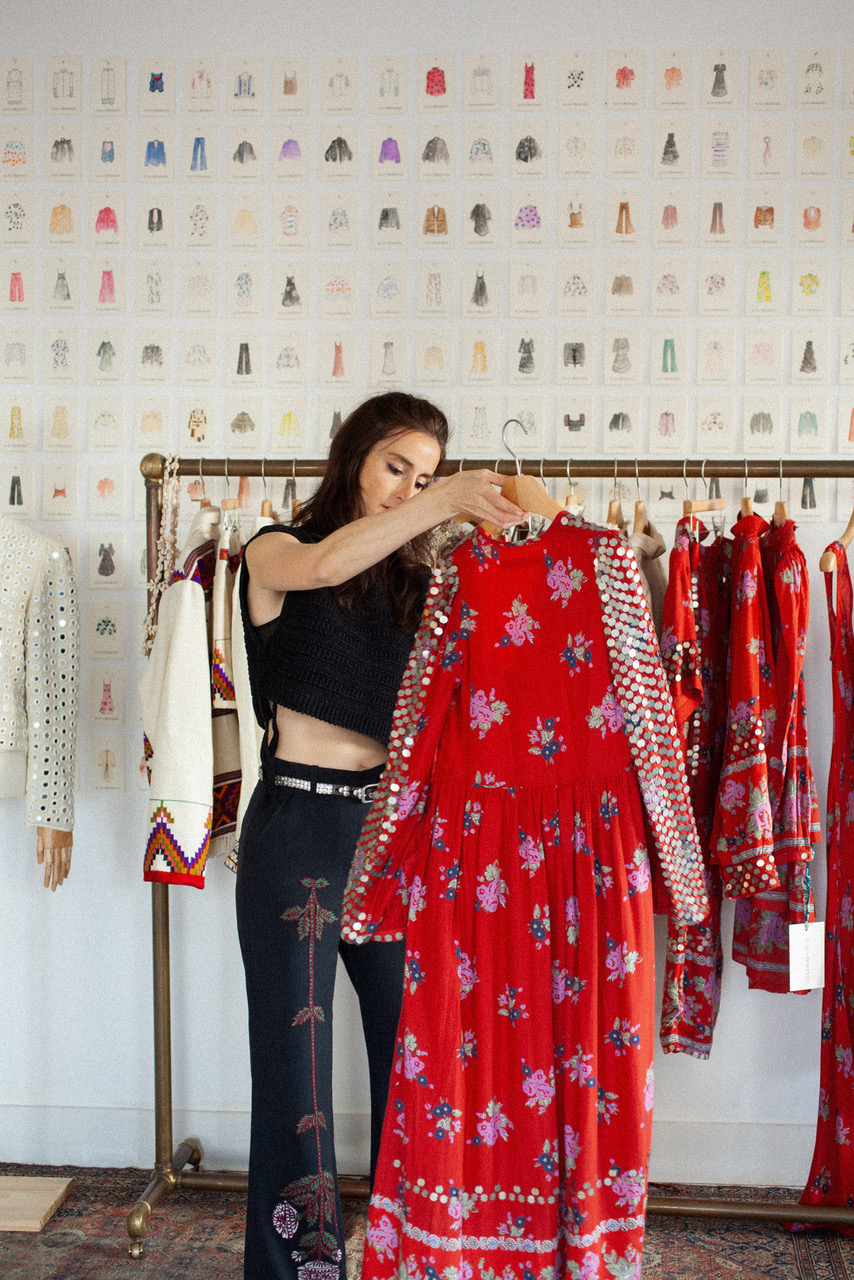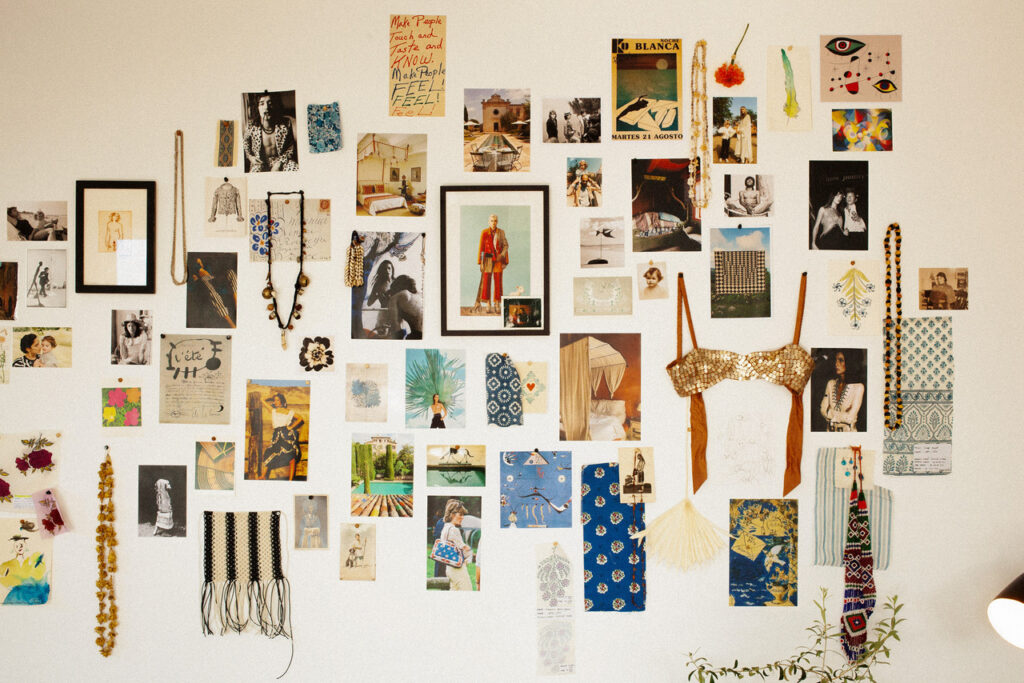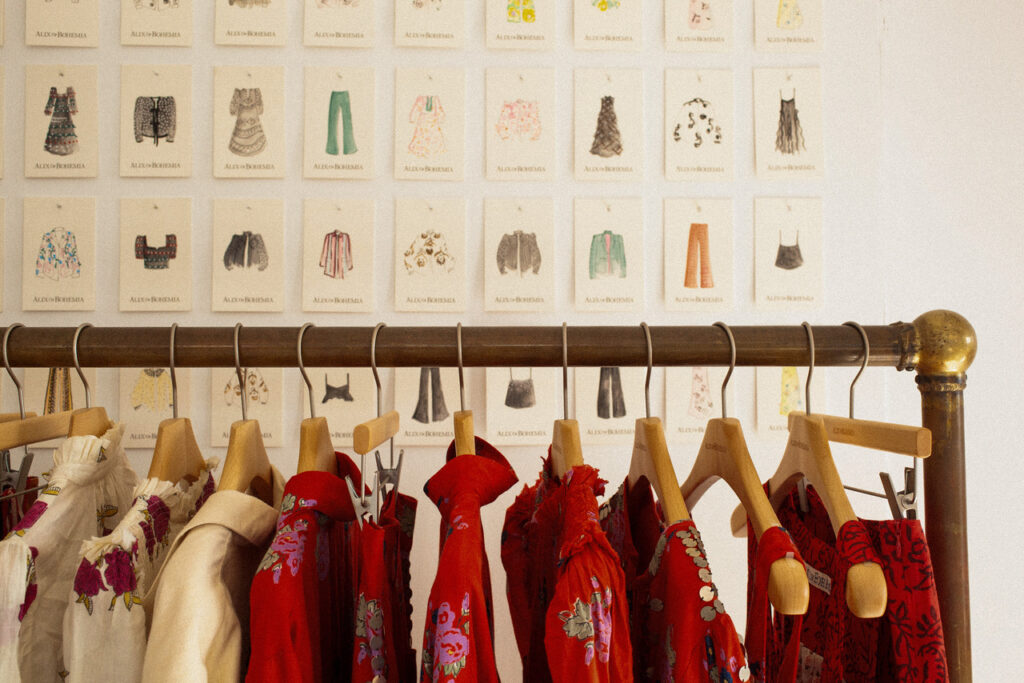Some people find their path in life unexpectedly, others follow the natural course of life, and some carry on their family heritage. For Alix Verley-Pietrafesa, it was a little bit of all three. Her brand, Alix of Bohemia, is a combination of her passion for vintage clothing and travel, her family connection to textiles and art, and her self-taught sewing journey.
Inspired by post-war bohemian culture and lifestyle, Alix founded a label that doesn’t just respond to a fashion market but embraces a life philosophy—one marked by a deep appreciation for cultures and the human touch. Alix of Bohemia portrays the nomadic soul, the care of handmade products, and the luxury of beauty.
We talked to Alix about her journey, which has taken her from Italy to France, Scotland, New York, Hong Kong, and beyond, about her brand, and what it means to embrace a bohemian lifestyle today.

C.B.: I just wanted to start with your background; you studied art history in Scotland…
A.P.: That’s right. I didn’t study fashion, but I came from a very artistic family. My mother is a ceramic artist, and my father’s family had a textile business in Italy for ten generations. So I grew up in a house that loved fashion and art—everything was very visual. When I moved from the U.S. to Scotland for college, I thought there would be a studio arts class I could take, like painting or ceramics. But there was nothing—just straight academics. I loved studying art history, but I really wanted a creative outlet, so I bought a sewing machine and taught myself to sew.
I was actually very lucky because I was studying post-war bohemians in Paris—all of these artists that emerged after this huge war and all of this loss. And all this creativity came from that. This kind of exploration of gender and social norms also came out of that. They called themselves bohemians, and I was kind of in love with this idea that clothing could facilitate a lifestyle, you know? So that was sort of what was in my head when I started to sew and create things.
C.B.: That’s really interesting. So how do you think this artistic background has influenced what Alix of Bohemia is today?
A.P.: I think because my mother is also an arts educator, growing up, we were always encouraged to play, to experiment with things, to express ourselves in a way that felt authentic. And there was also a big emphasis on making things beautiful—whether it was food at the table or something more traditionally artistic—to do your best, make it beautiful, and bring beauty into everyday rituals.
So, I think that sense of experimentation, not being afraid to fail, learning to play, and doing everything beautifully really influence my work. And also, an emphasis on learning—the collections always teach me something, which is really amazing.
C.B.: So, you have French heritage, Italian heritage, you studied in the UK, and you’ve lived and worked all over the world. How has this multicultural perspective shaped your brand?
A.P.: I think it’s been such a privilege not only to live all over the world but also to work all over the world, and with artisans. It has given me a deep respect and interest in other cultures. I’m always especially moved when we work in India, meeting people who have been practicing their craft for generations. It’s sort of reverential to be a part of it, to learn about it, and to incorporate it into my work. I always approach it with deep respect, and I consider myself a student of these people and their techniques. On the other end, it’s funny because when I named the company Alix of Bohemia, I imagined a girl who could go anywhere but wasn’t tied to any one place. She belongs to herself, comfortable in any setting. I think about that a lot when I create the collections—she doesn’t really belong anywhere, but she loves to travel everywhere. That’s the spirit of the woman.
C.B.: So, what was the main objective when you created Alix of Bohemia? What did you want to achieve by creating a clothing brand?
A.P.: I don’t think I set out to create a clothing brand in the beginning, to be honest. I was very inspired by vintage clothing, which I had started collecting as a teenager. When my Italian grandmother passed away, she left me all of this incredible clothing—from Valentino, Emilio Pucci—all so beautifully made. It felt very emotional. Of course, it was meaningful to me because it was hers, but also because these pieces had seen history. They were made with all these beautiful details just for the wearer—like paisley-printed silk linings, exquisite hand-finishing, and stunning buttons. I wanted to make clothes that felt like that for myself. That was really the beginning—thinking, What if I could create something that felt emotional? What if I could make clothing that made me feel connected in this way? And then people started to notice and asked me to make things for them as well.
And then, as I began the business, I started by making one-of-a-kind pieces. I sewed for many years, layering all sorts of textiles from around the world—some old, some contemporary—creating this sort of collage of, for lack of a better word, emotion. It was very expressive. I always loved the idea that you could wear something expressive, that clothing could say more about who you were than words ever could. That remains my intention today—to provide women and people with garments that make them feel unique, special, and protected. Pieces that will stay with them for a long time because they’ve been made thoughtfully, carrying the story of the maker, so they can feel a little more connected to something.

C.B.: And the brand is very connected to the bohemian style. But when we talk about bohemian style, we’re not just talking about an aesthetic—there’s also a lifestyle that comes with it. It’s about embracing slow living, a deep connection to nature, to oneself. So, what kind of lifestyle do you want to evoke with your brand?
A.P.: Yeah, beautifully said. I always think it’s funny when people assume boho style is just floral dresses or something like that. But it’s exactly what you said—it’s a love of travel, a respect for culture, a curiosity of a student, a love of ritual. It’s about being with friends, enjoying nature, being outside, really being present in the moment, and celebrating. We all have to get dressed every day, and while we’re not always dressing up, we want to feel good about ourselves, to feel good in our skin. So, to me, bohemian style is really about that—feeling confident, loving what you’re wearing, and dressing for yourself. It’s about dressing in a way that makes you feel comfortable.
It’s not about status. It’s about essence. And that’s what I think is so powerful about vintage clothes or things you find when you’re traveling. Those aren’t status symbols, right? They’re just things that you really love. That’s what I think bohemian style is about—dressing in a way that makes you feel like yourself.
C.B.: Okay, that’s really interesting. And I know that you also collaborate with artisans from all over the world to create the collections. Can you tell me more about these partnerships and collaborations?
A.P.: Of course. So when we started making Ready to Wear, I stopped sewing all of the pieces in the collection. My husband actually joined the company six years ago when we met, and he said, I really see the potential for this to be Ready to Wear. So we decided that if that’s the case, and we stop doing one-of-a-kind pieces, we still want everything to feel as special as, you know, made by my hands—maybe even more special. Almost every piece in the collection has a hand process behind it. For example, all of our shirts are printed by hand.
To achieve this, we went to India and started working with block printers, collaborating on how we could create something really special. A lot of designers now will take a block print from 100 years ago and digitally replicate it, but that eliminates the artist. It might look like something that was once hand-printed. Of course, it’s a slower process, and it’s not as stable because a human is not a machine. When someone’s block printing a motif, you’re going to have regularity, but also things that aren’t perfect—maybe an area where the ink smudged. But it’s going to feel much different and very special that it’s been printed by hand. And I think the wearer feels that. So that’s one of the ways we incorporate this craft—hand printing is very special to us. We collaborate with all kinds of printers all over India, some of which are family factories, which is very cool, and some are female printers, which is quite rare. Our crochet, for example, is all done by women. They actually do the craft at home in India, so they work on a very slow timeline.
And it’s all done by hand, which is really so special. You know, a lot of these things are being abandoned for machine processes in general. So I kind of do the opposite of what might be very efficient. I say, Can we do this by hand? This is a very cool idea, but I don’t want to do it on a machine. Let’s do it by hand. That’s always what is very interesting to me. Then, when we start working with a new artist or artisan, I usually spend a lot of time with them, side by side, so they can understand the craft, the process, and how we can technically make the best garment possible. But it’s always a beautiful conversation. We do have limitations because we do handwork—like maybe during monsoon season, we can’t print for two weeks. And you just have to accept it, right? And find a way to work anyway. It’s very special, though. And these crafts are dying. A lot of these things are generational, and new generations don’t want to learn them because they’re just not appreciated like they used to be.
C.B.: I think it’s really interesting what you just said. You’re working with cultures different from your own, so, it means that you have to accept certain things that maybe you don’t do yourself.
A.P.: And they have to accept me too,
C.B.: Exactly! So, how do you make sure that it’s not just a business transaction, but there’s also respect and admiration for the other cultures as well?
A.P.: I try to approach it as a student, I don’t go in and say, I want it to be this. I first observe what the art is, try to see how it’s done, and then we sit together and say, can we try this? Can we try that? Instead of imposing a design right away, I first try to understand the process and the people doing it. And, you know, it’s obviously a great privilege to have such skilled people make raw materials for our garments. So, I think it’s just about asking questions, being observant, and not being pushy. I don’t necessarily want to do it my way.
I have to be taught how it’s done. So, I think it’s really this openness of trying to learn and then trying to… What else is important to me is, you know, I really try to hold the story with me when we bring the clothes to market or when I meet a buyer. I always want people to feel interested in how the clothes were made, which is not always something we hear about. You know, we don’t really know how a lot of our clothes are made on the market, even at the very high level of designers. Sometimes the story isn’t being communicated. So, I really think that’s such a beautiful, cool thing. I try to hold the story, pass it on, and really celebrate that.

C.B.: One of the things I think is the most interesting is the fact that the clothing is handmade. As you say, these traditions are slowly being lost because everything needs to be fast and done in a certain way in the fashion industry. So, I think selling handmade articles makes them very personal, because it means that a human’s hands are creating something that will be worn by another human. It creates a very personal object, let’s say. So, for you, what is the meaning or significance of creating by hand in the fashion industry today?
A.P.: Well, first of all, it’s a huge privilege to have an audience for what we do. To be able to create like this, you know, the pieces are not inexpensive because they incorporate hand processes and human labor. What it means to me is feeling connected to each other and being part of something greater. It’s a very human thing, but I feel very reverential whenever I put on a garment that feels special. I say, “Oh, my gosh, I love this shibori dyeing on this.” It feels so emotional, and I know it was such an arduous process and such an old process. All of that feels very romantic and connected in a beautiful way. It’s part of something bigger and part of what connects us. Of course.
C.B.: There’s also a really strong sense of storytelling when we look at the different collections. For example, the latest one was inspired by the gauchos of Argentina and Uruguay and all the functionality in their clothing. So, when you’re conceiving a new collection, what’s the most important aspect for you?
A.P.: Sometimes there’s a stronger thread of inspiration than others, and sometimes the collection reveals itself as it comes. What’s most important is that I keep an open mind. The gaucho collection started with reworking this one print, a cowboy print. Then I started looking at imagery and became really interested. I love research. Sometimes I get an idea, and then I begin reading, thinking, and looking at imagery that might not directly inspire the clothing but inspires the feeling. It’s always about the emotion that comes forward. For example, now I’m working on a collection inspired by Gustav Klimt.
And so, I’m looking, obviously, at a lot of his work and the muses. He was really inspired by Byzantine mosaics. I love a multi-layered, intellectual inspiration that helps me visualize and really dream because there are so many exciting components to work with—so many prints, so many textures. I think staying inspired by being a student is key.

C.B.: So, what is it like for you to run a brand like Alix of Bohemia in an industry dominated by large luxury conglomerates and big brands?
A.P.: Yeah, you know, it’s amazing that we’re doing well. There’s so much competition, and I feel so privileged. It’s kind of amazing. I have no investors in my brand—it’s completely self-made from day one. So, it’s like, wow, I can’t believe this is how things turned out. I obviously have so much respect for the big houses and these luxury conglomerates, but I think of it as something a bit different. It’s not really the same thing. I don’t feel threatened; I feel there’s space for us. I especially saw that during the pandemic—people were really curious about smaller brands. There will always be the big houses, and that’s amazing. I hope that someday, in a different way, we can be one of them. I think Alix of Bohemia has a lot of potential to grow, of course. I admire them, but I also think it’s just a different thing. There’s space for all of us, which is really nice.
C.B.: And for you, what is it like to be a woman in a creative and artistic field today?
A.P.: You know, it’s such a privilege. I’m expecting my second child.
C.B.: Oh, wow. Congratulations!
A.P.: Thank you. We have a one-year-old, so it’s all about balance. Women are so remarkable in being able to do so many things at once. But I really love being a woman making clothes for women. That feels really special. I have a sense of how to connect with them through what I do. Working with women artisans adds another beautiful layer of connectivity. It’s incredible. It’s definitely not what I thought was in store for me, but I knew I wanted a different kind of life. It’s amazing that by teaching myself to sew, this brand unfolded. So, yeah, it’s a dream to be a woman in the creative field. I feel like it’s meant to be.
C.B.: Who is the person who shops at Alix of Bohemia? What is the kind of customer you have?
A.P.: I always say that she knows who she is and what she wants. She can be both rustic and refined. She’s well-traveled, loves art, loves beauty, and has a very warm heart. She loves music, loves to dance, and enjoys making people feel warm. So, it’s really about an engaged person who loves life, loves to travel, and loves beauty. I think that’s our woman.